This post is the third installment of a three-part series on Small Intestine Bacterial Overgrowth focusing on SIBO diet, food lists, and lifestyle changes. For more on SIBO symptoms and testing, see Part 1. For more on herbal antibiotics, supplements and probiotics for SIBO, see Part 2. For a more up-to-date and thorough resource, check out my new book SIBO Made Simple.
One of the questions I’ve gotten the most around my recent battle with critters in my small intestine is what’s the best SIBO diet.
There seems to be a lot of bewilderment around what to eat to combat SIBO on its own, versus what to eat during the “kill phase” of treatment, and then a whole lot more confusion when it comes to transitioning to the next phase of healing.
Though I’ve been seeing an integrative doctor in New York who did a fantastic job getting me the testing and diagnosis I needed, like many healthcare professionals, he’s only had so much rope to dole out when it came to gently towing me through the process of making over my life for SIBO.
The materials he offered at the moment of diagnosis were a small helping hand, but I’ve largely been on my own since, wading through the murky waters of internet information, and designing my own protocol the best I can.
In the last part of this series on treatment, I discussed the herbal antibiotic and supplement protocol I was prescribed. But the aspect of treatment that had the biggest impact on my symptoms were the changes I made to my diet, which included removing high FODMAP foods and making a host of modifications to not just what I was eating, but how I was eating it.
I’m going to discuss some of the opinions around these diet choices below. But before I do, I want to reiterate something I said in part 1: though your diet can certainly help you heal your gut from SIBO, it’s rarely the root cause, and therefore usually not the lone cure.
There is a difference between controlling symptoms and actually clearing the bacteria. And it takes a more complex approach than diet alone to do the latter.
For example, many people with SIBO might benefit first from trying digestive enzymes for IBS or a few of the other strategies I mentioned in my last post before taking on restrictive diet.
The reason I say this is to mitigate some of the fears I’ve witnessed around relapse.
The goal of any SIBO treatment–diet, supplements, or otherwise–is to get you eating a diverse, nutrient-rich array of vegetables, no matter how many fermentable sugars they contain. Staying on a restrictive diet long-term is not necessary for prevention, and may in fact be damaging to the overall health of your bacterial ecosystem in the large intestine.
As for me, I’m currently in the process of slowly reintroducing foods I removed, feeling out my tolerance, and continuing to give my digestive system some additional legs up. My new book, SIBO Made Simple, really lays out all these tactics in an easy-to-apply roadmap for all of you feeling overwhelmed.
If you’re looking for a helping hand experimenting with a SIBO friendly diet, the book also has 4-weeks worth of Low FODMAP meal plans and recipes that work for all the leading SIBO practitioner diets (Bi-Phasic Diet, SSFG, SCD, etc.).
It would be an honor to support you along this leg of your healing journey and provide all the support I can in the kitchen and beyond! The book includes helpful reintroduction worksheets for adding back in high FODMAP foods when you’re finished.
With health and hedonism,
Phoebe
WHAT DIETS WORK FOR TREATING AND HEALING SIBO?
It’s always important to be reminded that you have options. So, to start, I want to give you an overview of some of the most talked about diets for SIBO, and when during the treatment process, they are applied.
The main objective during the “kill phase” is to remove as many of your bacteria’s food sources as possible. And in brief, your critters like to feast on sugar.
The low FODMAP diet, which eliminates easily fermentable short-chain sugars that are found in many plants, and the SCD diet, which goes a step further and eliminates all sugars and grains, help alleviate symptoms by starving the bacteria of their favorite foods.
The secondary aim of these diets is to heal the intestinal lining by removing irritating ingredients and supplementing with foods that help rebuild. Since leaky gut is commonly associated with SIBO, thanks to unwanted bacteria eating away at your intestinal lining and creating more permeability, the healing phase is just as important.
Low FODMAP Diet (LFD): The most widely discussed option in conjunction with IBS and SIBO, this diet removes various types of sugars, including legumes, dairy, wheat, high fructose fruits and sweeteners (including honey and agave), artificial sweeteners, and many vegetables. It’s thought that some of these ingredients are poorly absorbed and irritating to the higher levels of the intestinal tract, so removing them gives you both relief from the unwanted gas that’s produced when bacteria eat your food for you, and also allows the digestive tract to heal. My podcast interview with Kate Scarlata explains why this diet can be so helpful for SIBO. You can find more in-depth information on the low FODMAP diet and how to cook for it in my book. You can also download my FREE low FODMAP e-book here!
Specific Carbohydrate Diet (SCD): Unlike LFD above, this approach is progressive, meaning that it begins strict and evolves to be more lenient as your gut heals. Grains, starchy vegetables, lactose, some beans and any sweeteners other than honey, saccharine and occasional stevia are prohibited. The diet also emphasizes cooked foods and minimal fiber in the beginning phases until your intestinal wall begins to repair itself.
SIBO Specific Food Guide (SSFG): This is Dr. Alison Siebecker’s hybrid approach. It combines the best of both diets above, reducing a broader range of fermentable carbohydrates than any other SIBO diet (including most sugars, grains, starchy vegetables, legumes, and dairy). It’s worth noting that Dr. Siebecker usually deals in more complex, serious cases of SIBO that have been hard to eradicate, so this more restrictive diet may be the approach of last resort after trying one of the two above.
SIBO Bi-Phasic Diet: Dr. Nirala Jacobi created a more actionable version of her colleague’s approach above. You can download the guide here.
Gut And Psychology Syndrome Diet (GAPS): a similar approach to the SCD, but with even more phases, the GAPS diet is thought of as a good option as a phase two to the low FODMAP diet during your healing phase. As you start reintroducing high FODMAP foods in slow, targeted intervals, you can also begin experimenting with some of the tennets of the GAPS diet which seeks to rebuild your digestive tract through daily bone broth and retrain your gut’s immune system through fermented foods like sauerkraut juice. Using lots of healthy fats like coconut oil and ghee in cooking also helps heal the gut and lubricate your system.
HOW STRICT DOES MY SIBO DIET HAVE TO BE?
These diets can feel like an incredibly complex jigsaw puzzle with countless inconsistencies and contradictions. Which is why I think the most important thing you can do is start somewhere, picking and choosing as many ingredients as you’re willing to give up without completely isolating your life.
The varying dietary approaches should be an empowering sign that perfection is not necessary for curing SIBO.
These types of elimination diets are not an exact science. And in fact, there is an argument to be made about teasing your system with high FODMAP foods or simple sugars during treatment to ensure that your bacteria don’t go dormant.
Many doctors, like Chris Kresser, don’t believe in completely reducing your critters’ food sources while on herbal or regular antibiotics. While these strict diets may prevent bacteria from multiplying, they can also cause them to go into hibernation, which means the medication won’t be as effective at killing the whole population.
The happy medium you want to find with your diet is between managing the more uncomfortable symptoms of SIBO and making sure your bacteria don’t go into hiding.
Here’s the sweet spot I found:
On my doctor’s recommendation, I began a low FODMAP diet in conjunction with a 4-week course of herbal antibiotics.
During the first two weeks, I took on a fairly restrictive approach with my diet, eliminating all added sugar, only eating whole grains (like brown rice and quinoa), and reducing my FODMAP’s as much as possible.
I figured that this was the stage when my bacteria were most prominent and out of control. I also wanted to reduce my symptoms immediately and begin to heal any permeability in my gut that may have resulted from the unchecked feeding frenzy that had been taking place.
In additional to the diet, I also decided to take on a month-long vice detox, meaning no alcohol or coffee, in conjunction with my kill phase.
Eating out was understandably incredibly difficult during the beginning stage. I only ate 2 meals at restaurants in the first 3 weeks! But at the halfway mark, I began loosening my grip slightly on the FODMAP elimination, allowing myself the occasional (like once a week) condiment or sauce at a restaurant that I knew probably had garlic or onion in it. This allowed me to a) have a more flexible stress-free life, and b) keep my bacteria on their toes, even if it meant a small set back in my symptoms.
The reason I didn’t go hardcore SCD is because I know my body and have found that my energy bottoms out when I am too strictly paleo/low-carb. My other medical advisor, Heidi Lovie, says this is fairly common with Hashimoto’s and one reason why it’s important to do some trial and error while taking on a SIBO diet. Whole grains with more insoluble fiber are less likely to give your critters a fast infusion of sugar to eat. And minimal portions gave me the carbs I was craving. It also made cooking at home 24/7, less of a slog when I could resort to a few quick fixes like quinoa pasta.
Hashi Posse, take note.
THE BIGGEST LIFESTYLE CHANGES THAT SUPPORT SIBO TREATMENT
With digestive issues like SIBO, it’s not just what you eat, but how you eat it. In fact, the way you consume your food could be a big contributing factor to what caused your SIBO in the first place.
You can review the root causes here, but most revolve around a malfunction of the Migrating Motor Complex, too little stomach acid, or structural impediments like scar tissue from abdominal surgeries or endometriosis. The lifestyle changes below can be game changers for some of these contributing issues—perhaps even more so than diet.
Try intermittent fasting. Some people will advocate for small meals throughout the day so that your intestines never have too much on their plate, so to speak. In my interview with Dr. Amy Shah, and through my own personal experience, I’m more apt to advise you to, instead, limit yourself to two meals a day and wait at least 14 hours between dinner and breakfast the following morning to let your digestion catch up. Especially if you’re SIBO-C, i.e. prone to constipation, this could be a game changer and something you might want to continue post-treatment.
Eat two main meals a day and avoid snacking. Part 2 of the first recommendation is to stop snacking. Your MMC needs at least 90 minutes in a fasting state to kick into gear. If you’re the type of person who always needs to be sticking small amounts of food in your mouth, this could be a big contributing factor to SIBO. In general, I’m not a big believer in snacking. It seems like a habit that’s been ingrained in us from packaged food brands that advertise on television, not an actual necessity for eating well. If you’re feeding yourself nutritious, well-balanced meals—meaning foods that are full of fiber, healthy fats and protein, and free of hidden sugars—on a regular schedule, you shouldn’t be facing the types of food cravings that drive snacking. If you find that you become starving two hours after lunch, it’s time to reconsider what you’re eating for those meals. Perhaps you’re not having a big or filling enough lunch. Perhaps you have bigger fish to fry when it comes to balancing your blood sugar. Use your SIBO protocol as a time to reboot how you look at meal time and find foods that keep you fuller for longer.
Drink lemon water before meals. Adding 2 tablespoons or fresh lemon juice or apple cider vinegar to 8 ounces of water before you eat will help stimulate your stomach acid. If this is a problem for you (and you can ask your doctor to test you for low stomach acid) there are also pills you can take to supplement Hydrochloric Acid.
Kick the Antacids and Proton Pump Inhibitors. Per the above, these drugs are not helping, they’re hurting. Your stomach acid is designed to kill bacteria and make it impossible for outside invaders to reach the small intestine. When levels are low, this doesn’t happen. Cue, SIBO.
Eat slowly and chew your food until it’s mush. When you have SIBO, your digestive system is already in distress. You’re not absorbing your food properly, and there’s bacteria competing for precious nutrient resources. The best way you can ensure easy assimilation and give your critters less substance is to chew your food as well as possible. This takes practice. Frankly, it takes forever. And it’s annoying. But it’s worth it. Your intestines don’t have teeth!
Start with cooked, soft foods and soups. Depending on how bad your symptoms are, and/or how bad you are at chewing, you may find it helpful to stick with soft or pureed foods during the first few weeks of your treatment. Cooked foods are generally easier on the digestive system, and simple soups allow for you to do less work if chewing is not your strong suit. Also, if you’re looking to save time, Epicured offers some fabulous low FODMAP pre-packaged meals.
Drink lots of water in between meals. Regardless of whether you’re SIBO-C or SIBO-D, staying well hydrated is hugely important for making sure your digestive system runs on schedule, and if you’re prone to the latter, replenishing some of the vital liquids you might be losing down the toilet.
Supplement with collagen. One of the big tenets of the GAPS diet is to drink bone broth every single day. Though it’s usually a leg of the diet that’s not incorporated until post-treatment, I think it’s a great addition during every phase of the process. Bone broth is packed with amino acids and collagen that help heal the lining of the intestines. Making your own stock is also an important first step towards cooking for a low FODMAP diet, since most commercial broths have garlic and onion in them. I basically had bone broth in my slow cooker for 4-weeks straight, adding more water and veggie scraps every day. If you don’t feel like making it though, you can buy collagen peptides and add them to your soups, morning tea, or smoothies. If you have histamine intolerance, steer clear of this one.
Try to wear looser clothes. Okay, okay. Not everyone wants to wear a muu muu to work. But perhaps during your kill phase, it’s worth giving your gut a break from the Spanx and other modern corsets. As we’ve learned, structural problems—meaning anything that constricts our organs and give them less room to do their jobs—is a precursor to SIBO. See what happens to your digestion when you give your insides a little room to breathe.
Get an intestinal massage. I mentioned visceral manipulation in part 2 of this series, but it’s worth repeating here. Practitioners of VM are adept at helping to break up scar tissue and other strictures that impede mobility of your intestines. This kind of bodywork is non-invasive and can do wonders for your digestion, even if you don’t have SIBO! More on this here.
HOW DO YOU PREVENT A SIBO RELAPSE?
I’ve heard from many of you who are afraid to loosen your grip on your diet for fear of relapse. In reality though, as I mentioned above, your diet is not what’s causing your SIBO, and therefore the second you stray from your protocol does not mean a switch is flipped and the bacteria comes back.
Once you’ve finished your treatment plan, waited 2 weeks to re-test, and gotten the result that your SIBO has been cleared, it’s time to start shifting your diet.
There are plenty of resources out there about how to reintroduce low FODMAP foods in stages, and I provide my own worksheets and guidance in the SIBO Made Simple book. Just remember that reincorporating inulin-rich vegetables and nutritious fruits is important for maintaining good overall gut health, which is equally important for prevention.
The second aspect of the healing/prevention phase is adding probiotics for IBS and fermented foods to ensure that your gut’s immune system is back on track. You may find that you’re sensitive to these foods for a little while, so make sure to go slow. I drank 1 tablespoon of kombucha every day for a week, then upped it to 1/4 cup, then 1/2. Now three weeks in, I’m drinking half a bottle.
In the GAPS protocol, it’s recommended that you add 1 tablespoon of fermented vegetable juice to your meals, which is another great tactic. Your doctor may also recommend taking one or several robust probiotics as part of your supplement regimen.
The most important aspect of preventing a relapse though is sticking with some of the lifestyle changes I mentioned above. When my system is feeling backed up and I’m not evacuating properly, I reach back into my motility tool kit: I skip breakfast, I drink more water, I try not to snack. I sip bone broth. If in dire straights, I’ll add smooth move tea or natural calm.
Luckily, your digestive system will tell you how you’re doing on a daily basis. If symptoms flare up, or you’re becoming less regular, you can always resort to eating low FODMAP for a day, opting for pureed soups, or chewing your food until it’s pulp.
You also may want to consider continuing with some of your supplements, as I have. Particularly digestive enzymes, the occasional drop of oregano oil, and a prokinetic.
The latter is something I started immediately upon completing treatment, and something I may need to rely on indefinitely to ensure my MMC is running as it should. Here is a list of options to explore. I am currently on Low Dose Naltrexone and I can really feel the difference in how things are moving through my system.
Finally, the biggest thing you can do to treat, heal and prevent relapse of SIBO is to get your stress under control. Stress is a noted contributing factor to developing SIBO, and certainly one that will make symptoms flair up even once the critters are gone. Our gut has a mind of its own. Literally. And it’s irrevocably connected to how we think, feel, and process uncomfortable emotions and fears.
You can’t cure this. It’s a fact of life. What you can do is tackle the problem from both ends: eat for your gut and make room in your days to soothe the mind. Go to yoga, journal, soak in the tub, meditate, take daily walks–whatever you need to do to unwind. If this has been a historic problem that you have yet to tackle, we cover many of the strategies I just mentioned and more in my online course.
You can also explore protocols like Hypnosis for IBS – check out this episode of my podcast for more info.
MORE RESOURCES
- The SIBO Made Simple book (now on shelves everywhere!) takes all the learnings from 50+ interviews with practitioners and distills the advice into a 350 page practical roadmap with 90+ Low FODMAP recipes, and advice / food plans for low histamine, yeast and candida-friendly and low sulfur approaches.
- The SIBO Made Simple Podcast covers each puzzle piece of SIBO and breaks it down into easily digestible terms. Here are some topics we cover:
- SIBO Breath Testing
- The Elemental Diet
- Post-Infectious IBS & Food Poisoning
- Methane & Hydrogen Sulfide SIBO
- Candida & Yeast Overgrowths
- Leaky Gut & Autoimmune Disease
- SIBO & Hypothyroidism
- SIBO & Celiac Disease
- Mast Cell Activation Syndrome
- Heavy Metals, Mold & Other Toxins
- CBD Oil & SIBO
- The Low FODMAP Diet
- The Bi-Phasic Diet
- SIBO & Intermittent Fasting
- Skin Issues and SIBO
- Probiotics and Prebiotics for SIBO Treatment
- Healing Structural Issues
- Fertility & SIBO
- Histamine Intolerance & SIBO
- How SIBO Effects Depression and Anxiety
- Acupuncture for SIBO Healing
- Busting Biofilms
- Dr Allison Siebecker’s site is hub of amazing information, SIBOinfo.com
- SIBO 2.0: How to Find the SIBO Treatment That’s Right For You
- SIBO 3.0: The Best Diets and Lifestyle Changes to Treat, Heal and Prevent SIBO From Recurring
- My FREE Low FODMAP Weeknight Meal E-Book
Want more FREE SIBO tips directly in your ear?
SUBSCRIBE to my podcast SIBO MADE SIMPLE
Disclaimer: this website offers health, wellness, and nutritional information for educational purposes only. Information provided is not intended as a substitute for the advice provided by your physician or other healthcare professional. Always speak with your physician before trying any new treatment.

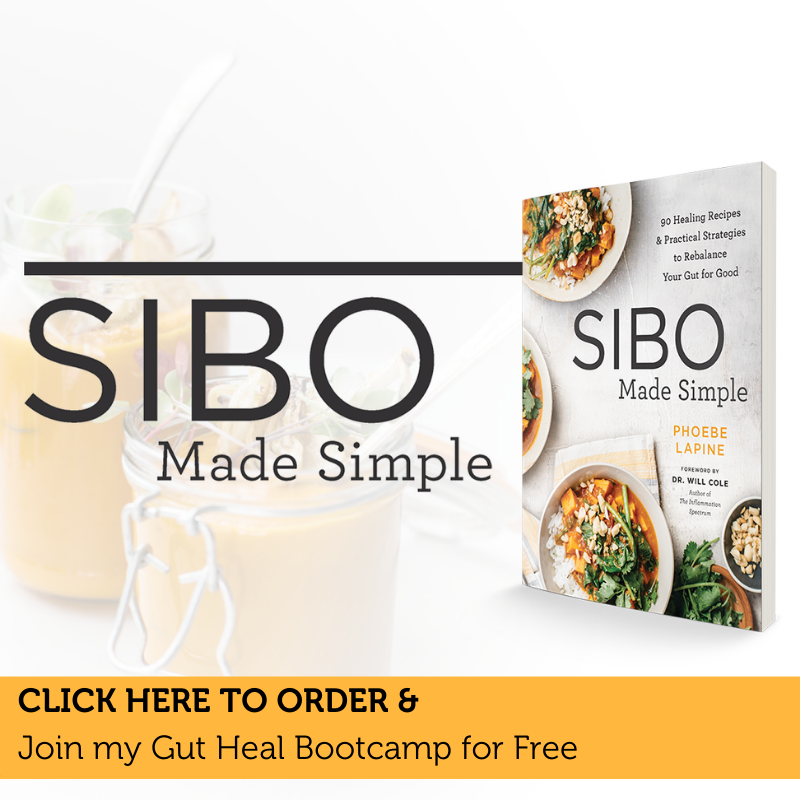
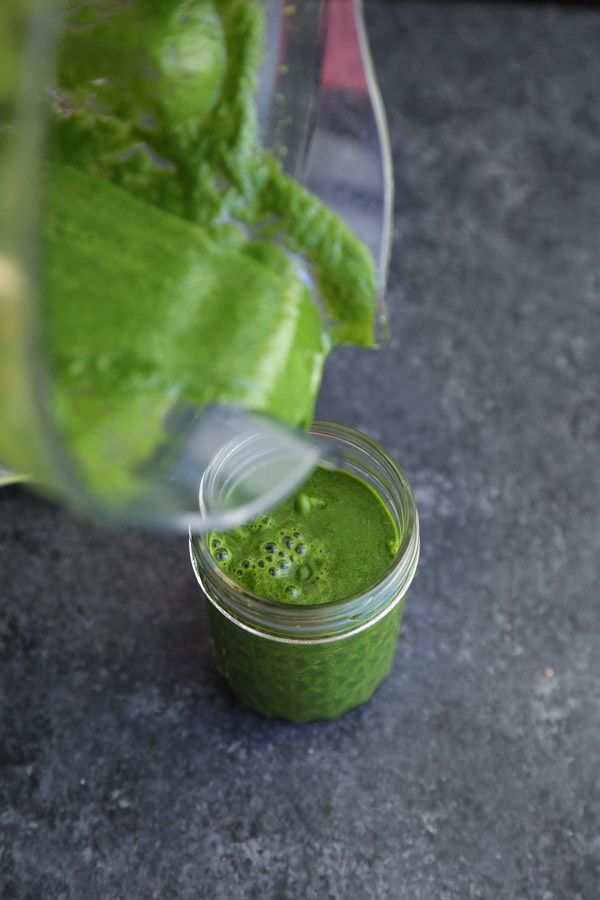
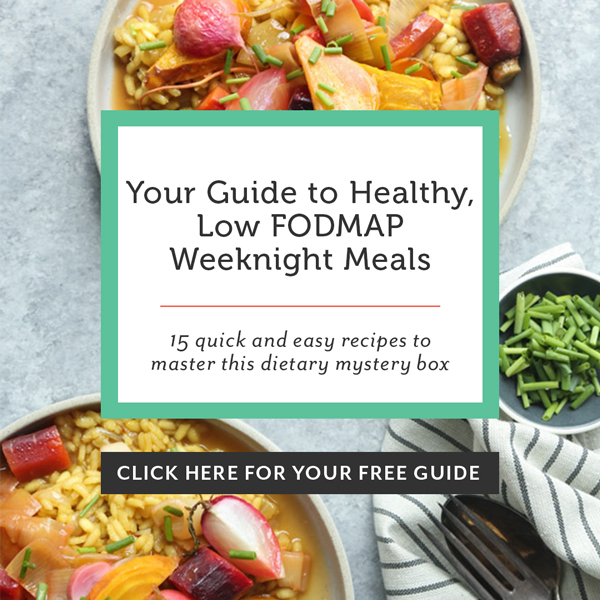
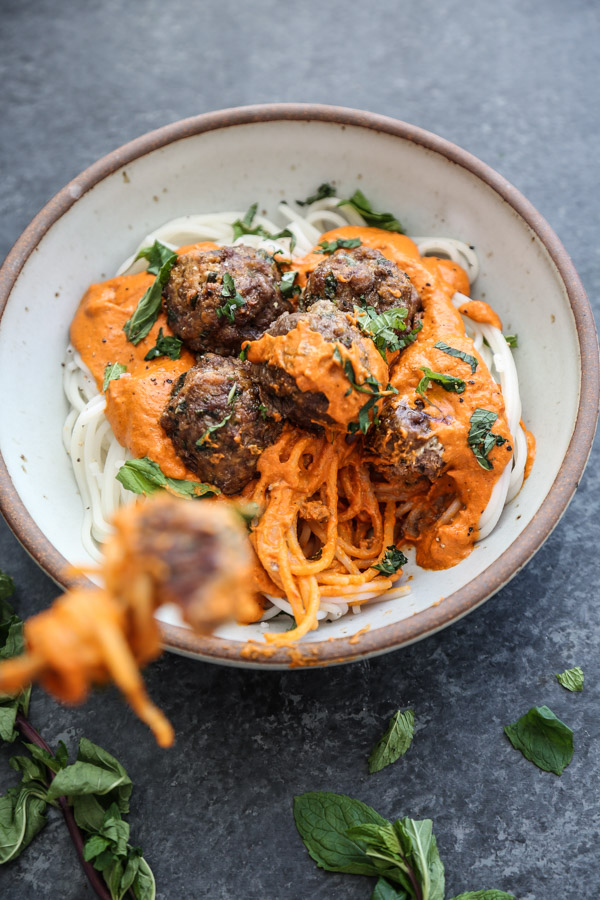
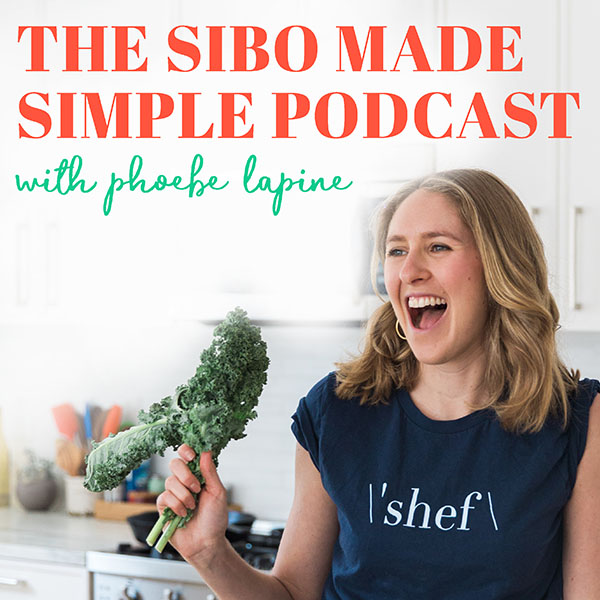
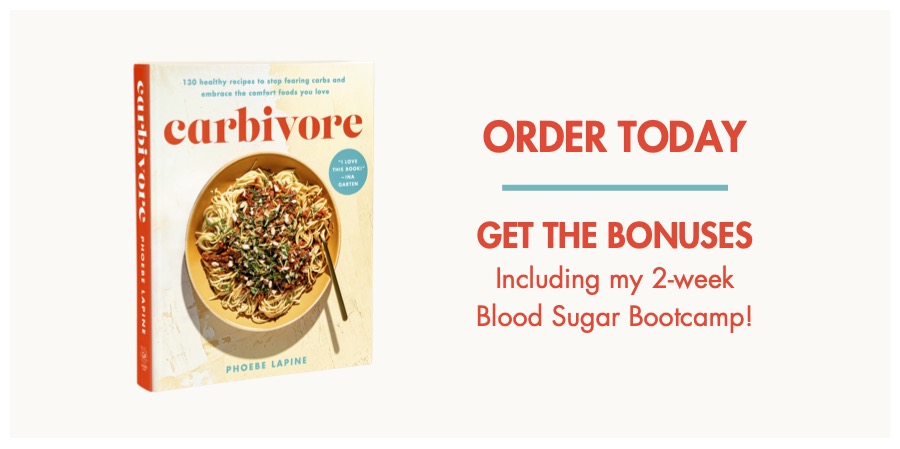
Your site is one of the most informative (and believable) sites I’ve come across. You’ve certainly gone through your trials and tribulations getting to where you are now. I am currently in the process of discovering if I have IBS. I have probably 99% of the symptoms you’ve mentioned; although, I had never heard of SIBO until now. I’ve been on proton inhibitors for almost a year now and they seemed to help in the beginning but not anymore! You are a gem of a person for your “free” information, I can’t thank you enough.
Thank you Valerie! Its really nice to to be recognized for all the work that goes into this site. Especially that it’s done for FREE! With all the free stuff out there these days sometimes it feels like many take it for granted. I’m so glad this was helpful for you – that’s why I do the work! xo
Where do you get LDN? I can’t find a Dr to prescribe it. I’ve resorted to the internet in the past. I’ve used for MS and now have been diagnosed with SIBO. I would like to start back on it after my treatment. Thank you
My doctor prescribed, but I had to go through an online pharmacy that does compound formulas. Most doctors should be able to give you the prescription, you just may have to track it down. My bottle says Healthy Choice Apothecary on it.
Hi Phoebe,
Thank you for this clear and informative article.With Hashimotos I have blood sugar regulation problems. It was suggested that I eat every two hours to manage it. I’ve been on a Low FODMAP diet off and on (it’s been triggering my Eating disorder), avoiding foods that I am sensitive to (the list is long) and a long list of suppmemts to treat the SIBO and Hashi. Now I’m wondering if I am wasting my time because I haven’t been meal spacing at all. Do you have any suggestions on blood sugar management while meal spacing? I eat high protein, moderate fats and low to moderate carbs.
If you eat moderate carbs, you shouldn’t have as many blood sugar peaks and valleys. Eat a salad before eating your carbs, focus on bigger meals, and you should be able to get more time in between no problem.
Hello Phoebe,
I’m about to do the natural antibiotic approach, but i have a question I don’t seem to find the clear answer. I have been on a low food map diet for a while now, but when is start the treatment (killing face), do I keep with the LOW Food Map diet or do I eat normally, including starches, onions….?
And then, i go back to low food map on Face 2 for the Recovering face?
Thanks for your help. I’m so lost and I’m so depressed. I feel alone on the ocean and your help means the world to me.
Hi Pau,
There are a few schools of thought on this. Some definitely think it’s important to reintroduce some carbs so that the bacteria has more to feed on during the antimicrobial phase. Check out Nirala Jacobi’s bi-phasic diet. She does a restrictive diet first to help clear some bacteria initially and lesson die-0ff, then loosens it up a bit once the medication is started. Something like that could work for you. Low FODMAP is best not to do long term, so you could begin your rest phase re-introducing certain ingredients to see how you react and also feed some bugs in the process. I wouldn’t go full-force eating normally if you’ve been restricted for a while. Hope this helps. I know it’s overwhelming, but there’s hope! xo
That’s so delicious.
Hi Phoebe-
As part of your Biotics protocol, did you do just the Probiotic every other week for 6 weeks as they recommend?
Second question- I have tested positive for SIBO twice on the first test each time. Therefore I never get to drink any test liquid to dive deeper into Methane vs Hydrogen. Should I be asking for a different test?
Thank you!
Jenny
I didnt take a probiotic during treatment. Only after.
The breath test includes 10 samples. The baseline would not be able to confirm SIBO. You should seek out a real lactulose breath test if you want to confirm SIBO. There’s a link in the 101 post!
Dear Phoebe,
Thank you for the “godsend” information. I am trying to cure my daughter’s SIBO:
Just wanted to point out that this link isn’t working:
Here is a list of options to explore. I am currently on Low Dose Naltrexone
Regards
For the recommendation to eat two main meals a day, does this include those who have higher caloric requirements (around 2200-2400, for example)? This would mean over 1000 calories per meal, and given the nature of the recommended diets, would be a hefty amount of fat per meal. Would you still recommend this approach for this situation?
Hi Jason, there are several ways to look at meal spacing. Most important thing is to have 4ish hours of downtime between meals. You can definitely accomplish this with a third meal, just don’t snack in between.
There’s nothing wrong with eating high fat, unless you have gall bladder issues or something like that.
Hi Phoebe,
Your site has been the most valuable, easy to understand and comprehensive info I’ve found on SIBO so far.
After going through multiple gastroenterologists that are clueless on the condition, I finally self-diagnosed with SIBO with an in-home online test and also tested positive for SIFO on the spit test. I suspect it was all caused by a 25 day course of broad spectrum antibiotics due to a tough wisdom tooth infection and a vegan diet high on carbohydrates.
I have question to you which I have not been able to find any answer for. What is the best probitotic regimen post herbal treatment (Metagenics)? I’ve been doing soil-based probiotics currently but I wonder what should I do next.
Thank you so much for your site and any advice you can give me.
I recently have been diagnosed with IBS & SIBO. I was looking to see if there is a diet that can eliminate. I found your site and as I read thru it it made so much sense to me. I have had gut problems my entire life. And I have done many things “fix” it. It was refreshing to read your article. It details the problems in simple terms and how to “manage” it.
so happy to help! you will like the podcast too!
Hy Phoebe,your articles are GREAT! What do you think about aip diet combined with low fodmap, considering the presence of hashimoto,or starting with aip and continuing with lowfodmap?
AIP is not necessary for Hashimotos. There’s a whole post on this 🙂 https://feedmephoebe.com/autoimmune-paleo-diet-hashimotos/
General hierarchy: regular elimination diet, then low FODMAP, then paleo low FODMAP. You should have plenty of answers about what you can handle after a regular elimination diet. If there are still issues, add FODMAP.
Thanks!
Can I take collagen supplements before the lactulose test? Or do I need to stop taking it?
Thank you!
Phoebe not sure if you have any info or can help me. Two years go I had Lymes Disease. Since the Lymes Disease my stomach and gut have never recovered. The Lymes virus never leaves you, you have it forever, and the virus can live in your stomach and gut forever!! I have found some infor that suggests that Lymes Disease can cause SIBO. Through my Gastroenterologist I am scheduled to have the breath test in Dec at the University of Pennsylvania. On my own I have tried enzymes, probiotics, prebiotic, I take a supplement called Atrantil which consists of Quebrachio, Horse Chestnut and Peppermint Leaf which is suppose to relieve digestive issues. It targets the small bowel to provide relief where digestive issues begin and it reduces overall gut irritation and helps with gut motility. It does help but is expensive and can only be ordered online. I was diagnosed with IBS 10 years ago and have been taking the prescription Amitiza twice a day since my diagnosis. I experience brain fog, short term memory loss and my attention span is not quite up to par but these are all common long term effects of Lymes Disease. I am 63 and in great shape, taking yoga, pilates and barre classes 3 times a week. I just want to get rid of my belly bloating and loose the 5 lbs I have gained since the Lymes and more important feel like my old self again. Any suggestions??? Thank you in advance, you blog is wonderful and so informative. It’s Better than any website I have found regarding SIBO.
Hi Phoebe, I’ve been diagnosed with IBS after many tests ordered by my GI doc came up with nothing. I suspect SIBO, and will be asking my functional medicine doc about a lactulose breath test. Can you tell me about the use of honey on the SCD diet? I’ve started heading more in the SCD direction, as the LFD wasn’t completely working for me. I see more improvement with SCD, but am so confused about the whole honey thing, is it okay to eat or not? I have Breaking the Vicious Cycle, but feel that maybe it’s partially out of date. I’d love to hear what you have to say about honey, because your website is the absolute clearest of them all, and so encouraging too. Thank you!
To everyone reading this excellent blog, I followed Phoebe’s SIBO protocol and defeated SIBO. But not all the symptoms. I had done a stool test at the beginning with a very good company (Parasitology Center in Scottsdale AZ), and they found Parasites, specifically nematode (roundworm, pinworm, et al). Symptoms for SIBO and parasites are almost identical. I went on a RIGOROUS parasite protocol while still doing the SIBO protocol, and suddenly I started losing LOTS of weight that I wasn’t intending but glad to have happen. I was seeing critters in the toilet, which you will see if you go hunting for them. My symptoms are almost completely gone now. My advice to all of you is to go after SIBO and parasites at the same time, not knowing for sure which one(s) you have. Good luck to all!
Thank you for sharing Sandy!! Congrats on feeling better
Sandy,
Congratulations on feeling better!!
Did your doctor recommend the stool test or is this something you did on your own?
Thank you for the great info. Just diagnosed SIBO positive for both Hydrogen and Methane after 7 months of agony. Will be starting antibiotics soon. I am struggling with the diet SSFG prescribed by my doctors but the information here is helpful.
Hi there!!
Did you have Greek yogurt during the kill phase?
Hi there, Thank you so much for all of this info it is so helpful. I had a question about fermented foods. During the time you are on the Biotic herbal medication stage, should you not have any probiotics or fermented foods? I eat tons of fermented foods, coconut kefir and Cocoyo coconut yogurt. Is it better to stop all of these while on the 4 week protocol? Any advice you have on this would be great. Thank you!
Thank you so so much for all of this helpful information. I had SIBO a few years ago and I believe I’m having a relapse. This is helping me get back on the right track to rid my body of these evil villains. Did you suffer with GERD symptoms with the SIBO?
I personally did not, but you should check out this episode of my podcast that talks all about GERD and stomach acid’s role in SIBO: https://feedmephoebe.com/low-stomach-acid-gerd-hpylori-sibo-natural-remedies/
Hi! Just wondering what your take is on lactose-free or coconut yogurt during the elimination phase. It is allowed according to the low FODMAP diet but I’ve heard it suggested that you should stay away from probiotic containing foods during this time.
Thanks!
It’s really a matter of what you tolerate and what your underlying causes are. I personally stayed away from fermented foods until the sibo wad gone and then used them in the healing phase.
Thank you so much for all of this information. I’m new to SIBO and SO overwhelmed. Were you able to determine your root cause? I also have hashimotos, but it has progressed to hypothyroidism which I had controlled well. But I switched thyroid meds and things went haywire, then I developed SIBO when my thyroid levels were not where they needed to be. I hope you continue to stay SIBO free!
i have a question, with sibo for the stomach acid youre saying that food does’t cause that if you have sibo? what can i do or take to prevent the acid belching i get after each meal? please and thank you! Also what herbal things to take to help with getting rid of the backteria?